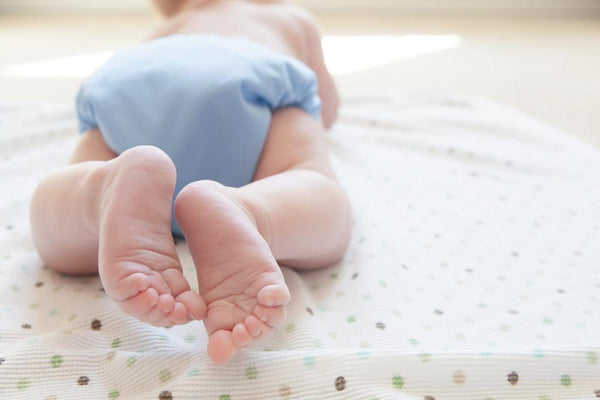How To Wash Cloth Diapers

We sent an email with a link to update your password

Whether you’re a first-time parent or a seasoned pro, you’re probably familiar with the cloth diaper craze. But if reusable cloth diapers have scared you away in the past, we’re here to ease your cloth diaper concerns! Let us guide you through the cloth diapering transitioning process, including the benefits, everything you need to get started, and (most importantly) how to clean reusable diapers. It’s not as messy as you think).
Click the steps below to learn how to wash cloth diapers, or read our comprehensive guide to learn everything you need to know!
There are many reasons parents choose to use cloth diapers instead of disposable options. Here are a few reasons you might want to consider doing the same:


Cloth diapers haven’t ever had a great reputation for convenience. For many parents, the continuous changing and cleaning routine seems daunting. But what parents should know is that there are many different types of cloth diapers. The traditional hand-stitched variety your grandmother might have used is not the only one available anymore!
Cloth diapers have undergone significant improvements to become more accessible and convenient for busy parents. Let’s discuss some of the cloth diaper options available today.
Prefolds are most like what you associate with a traditional cloth diaper. They’re folded and stitched with thick layers in the center to help absorb potty waste. Prefolds should still be combined with a cloth diaper cover to provide a waterproof layer and ensure there’s no leakage.
If you’re unsure about making the transition to cloth diapering, you might want to start with hybrid cloth diapers. Hybrid diapers combine the convenience of a disposable diaper, while still providing many benefits of choosing cloth diapers for your child. Hybrid cloth diapers generally have a waterproof layer on the outside and an absorbent layer on the inside. For the inside layer, parents can opt for a disposable insert or a cloth insert. While disposable inserts can only be used once, they generate significantly less waste than a fully disposable diaper. Cloth inserts, on the other hand, are typically made of cotton, microfiber, or hemp and can be reused after a wash.

All-in-One cloth diapers are another easy transition into cloth diapering. This style doesn’t require any added layers. All you’ve got to do is wash the whole diaper after use and you’re good to go! Don’t worry, we’ll get to how to wash cloth diapers step-by-step soon!
So, you’re convinced. You like the idea of possibly saving a little on your baby budget, you want to do your part for the environment, and, of course, you’ve weighed the pros and cons of cloth diapers. You’re ready to take on cloth diapering with confidence. But before you start planning your laundry schedule and picking out adorable cloth diaper patterns, there are a few other things you’ll want to have in stock.


So you’ve got your cloth diapers and related supplies. But before you introduce your baby’s skin to any fabric product (including cloth diapers), it’s a good idea wash the diaper beforehand. “Prep” your cloth diapers by washing them with a scent-free detergent and dry them on a low tumble cycle or on a drying line. You’re ready to start cloth diapering!
Before throwing a dirty diaper into the wash, make sure to pre-clean it by flushing solid waste and then rinsing the cloth diaper with cold water. For a more convenient option, you may want to invest in a diaper sprayer. A diaper sprayer can be installed on the side of your toilet to make rinsing dirty diapers easier and less messy!
After you rinse off the residue, run a hot wash cycle with laundry detergent.
Following the wash cycle, rinse the cloth diaper again to removing any remaining laundry detergent.
Dry cloth diapers on the low tumble cycle with medium heat or use a drying line to air dry cloth diapers. Letting Mother Nature do her work!
Cloth diapers should be changed more frequently than disposable diapers because they’re less absorbent. Plus, they’re more likely to get stinky and hold onto unpleasant odor, which is not ideal when you’re reusing them! So, first thing’s first. Change baby’s cloth diaper about every 2 hours throughout the day (or once you’ve noticed that their diaper is wet or soiled).
So, how often do you need to wash cloth diapers? Leaving soiled diapers in a diaper pail too long is the quickest way to ruin your set of cloth diapers. Make sure you’re on top of your laundry schedule to keep them in good condition for as long as possible! Wash soiled diapers every 2 to 3 days, or according to the manufacturer’s instructions.
Maybe you’re sold on the cost savings of cloth diapers, or perhaps you’re a steward of the environment and want to reduce your waste footprint. But you still might be wondering, “Are cloth diapers really for me?” We say, why not give it a go? Parenting is a healthy balance of trial and error, plus a sprinkle of advice and experience, after all!
The most important thing to remember is that every parent and child is different, so while cloth diapering may work wonders for you, it might not be the right solution for your friend or neighbor. So use that parental intuition and crafty “know-how” to see if cloth diapering makes sense for you and your child!
To ease the cloth diapering transition, we’ve included some additional resources and cloth diapering communities to help you learn more!